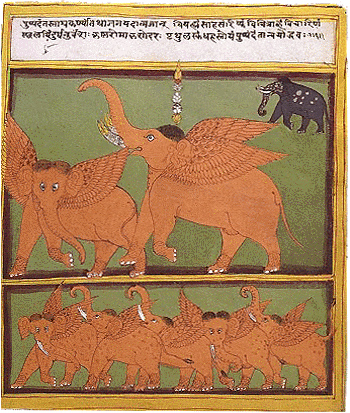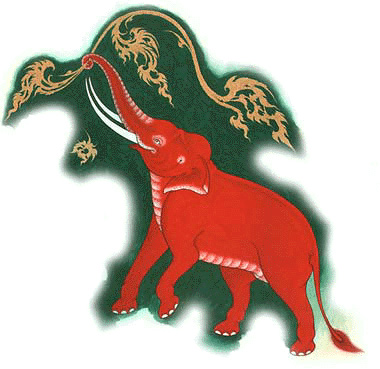The Science of Elephants
BY: SUN STAFF

Oct 19, CANADA (SUN) — Elephants hold a unique and important place in the Vedic culture, both in mundane society and in the temple environs. The care and husbandry of elephants is documented in great detail in the Gaja Sastra, a definitive instruction on the science of the elephant. Gaja Sastra was authored by Palakapyamuni, who is said to be the offspring of Samagayanamuni and a female elephant. The image above is a manuscript page from Gaja Sastra, giving the Sanskrit text on the upper halves of pages and on the lower halves, a metrical translation in Marathi of the text above.
Gaja Shastra deals with the behaviour and characteristics of elephants, and gives the methodology of how to categorise elephants on the basis of certain bodily marks. Kumaraswamy has written exhaustively on Gaja Sastra. In his purports, he has given 16 methods to test various marks on the bodies of elephants.
The science of elephants is also dealt with in the Brhat Samhita. The following text is taken from Chapter LXVII, "Signs of Elephants":
"Those elephants are called Bhadras whose tusks have the colour of honey, limbs are proportionately developed and distinct, which are not too stout, nor too lean, are fit for work (quite active), have equal limbs, backbone resembling a bow, and hips similar to those of boards (i.e., round).
The characteristics of the class designated as Manda are: a loose breast, loose folds on the waist (or loose waist and folds), a hanging belly, thick skin and neck, huge belly and root of the tail, and a leonine look.
Those that belong to the Myga class have short lip, tail-hair and penis, slender feet, neck, teeth, trunk and ears, the large eyes (or pupils). Those that belong to the Sankirna class have the characteristics of the above three classes intermingled.
The height of an elephant of the Myga class if 5 cubits; length, 7 cubits; and girth, 8 cubits. These numbers increased by one are those of the Manda class (i.e., 6, 8, and 9 cubits respectively); by two, of the Bhadra class (i.e., 7, 9, and 10 cubits). The Sankira has no fixed dimensions.
The colour of the Bhadra elephant is green; so is its ichor [water produced during rut]. That of the Manda class is yellow and its ichor too is yellow. That of the body and ichor of the Myga type is black, while that of the two of the Sankirna type is of a mixed nature.
Blessed are the elephants that have red lower lip, palate and mouth; eyes like those of sparrows; glossy tusks that are raised at the lips; long and broad face; arched and long backbone, lying deep and not protruding; the frontal globes resembling the back of a tortoise, and covered with thin and scanty hair (each pore having a single hair); broad ears, jaws (chins), navel, forehead and penis; 18 or 20 nails that are convex like the tortoise; round trunk covered with three vertical lines; fine hairs and fragrant ichor and breath.
Elephants with long fingers and red tip of the trunk, with its trumpeting similar to the thunder of clouds, and with a long, broad and round neck, bring good fortune to a king. [The fingers of elephants are the fleshy projections on the tip of the trunk.]
Elephants that are never intoxicated, that have too many too few nails and limbs, that are crooked or dwarfed, whose tusks resemble a ram's horns, whose testicles are prominent, which are devoid of the special lotus-shaped tip of the trunk (i.e., Puskara), whose palate is dusky, blue, variegated or black; which have tiny tusks or no tusks at all, or are impotent, are to be removed by the king to another country, as they produce very disastrous results. The same treatment should be given to a cow (elephant) which has the characteristics of a bull and to one that is pregnant.
The tip of the trunk is called Puskara as it is shaped like a lotus. Matkuna is an elephant without tusks. An impotent elephant is called Sandha. A new type of elephants called Vikata, not mentioned in Brhat Samhita, is described by Utpala, who writes: Why should the king send such unwanted elephants elsewhere? According to the Dharmasastra, elephants ought not to be killed except in battle. The term given is not merely 'another country', but and enemy's country, because the king would wish that his misfortune might overtake his enemy."

In Brhat Samhit, Chapter XCIV is described the attitude of elephants"
"The elephant's tusk should be cut off at a height that is equal to twice its circumference at its root; but in the case of elephants roaming about marshy places a little more than the above should be left off, and in the case of those of mountains, a little less.
If the cutting of the tusk be white, even glossy and of good smell, it would bestow prosperity. The effects of the dropping down, and the fading of colour of the tusk are similar to those of its breaking.
The Gods, demons and human beings reside in the root, middle part and tip respectively of the elephant's tusk. The effects of omens in these parts will be in order great, moderate and slight, and will be felt in a short time (i.e. within a week), after some time (i.e. within a month), and after a long time (i.e. after a month) respectively.
The effects of the right tusk breaking in these three parts (viz. root, middle and tip) are severally the fleeting of the king, the population and the army; of the left tusk, destruction of the prince, royal preceptor and the mahout, as well as of the army of mountaineers the king's consort and leading personages (commanders) respectively.
If both the tusks are found to break, complete ruin of the royal family is to be predicted; but if the splitting occurs in a benefic ascendant (Taurus, Gemini, Cancer, Virgo, Libra, Sagittarius or Pisces), lunar day, asterism and the like, there will be an increase of prosperity and happiness; otherwise, there will be an increase of misery.
If the elephant be found to break or split the middle of its left tusk by striking against milky trees, or trees laden with sweet fruits or flowers, or against the banks of rivers, the destruction of the enemy si assured; otherwise (against thorny trees etc.) or at the breaking fo the right tusk (or of the left one at the root or tip), there would be prosperity to the enemy.
(Elephants, and even bulls, indulge in a sport called Vapra-krida in Sanskrit literature. This consists in the animal striking an embankment with its tusk.
If the elephant has a stumbling gait, if its ears stop beating suddenly, if it appears very dejected, if it breathes soft and long, placing its trunk on the earth, if its eyes are full of tears or closed, if it is always sleepy, if it behaves in a refractory manner, if it east something unwholesome, or if it passes blood and dung too frequently, it forebodes danger.
If the elephant breaks wantonly ant-hills, trunks of lopped trees, bushes, shrubs (or small trees) or trees, if it looks jolly, if it goes in the direction of the march, with quick steps, holding aloft its face, it at the time of its being accoutred it ejects spray or trumpets repeatedly, or if it gets intoxicated at the time, or if it takes its trunk around the right tusk, it confers victory.
If an elephant is dragged into the water by a crocodile, the king will be destroyed; if on the other hand, the elephant should drag the crocodile from the water to the bank, the king would be victorious (and prosperous)."
